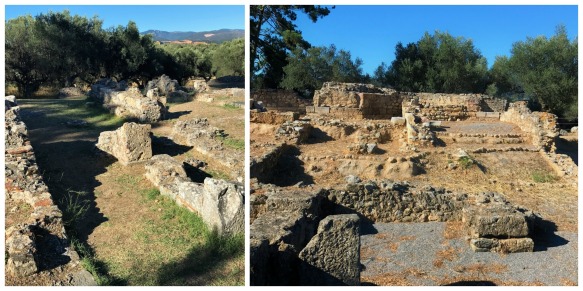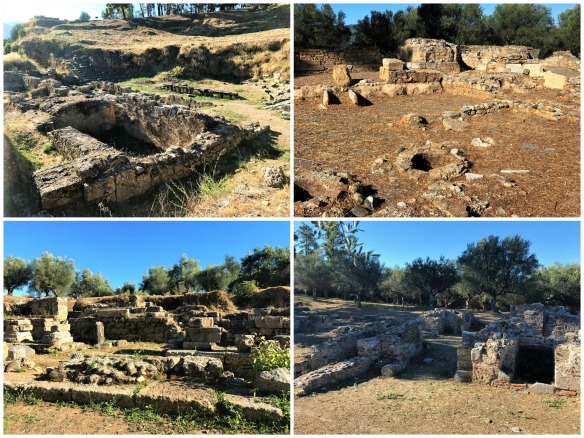Sparta–the nexus of my family. Wouldn’t you think that three weeks would be ample for research? I worked hard, but I ran out of time. And my “next trip” list continues to grow.
My home base was the General Archives of Greece, Sparta office. Pepi Gavala, Archivist, and her staff, Michalis and Electra, are friends. They welcomed me with much hospitality, patiently answered endless questions and fulfilled requests for many records.
While searching Dimotologion (Town Records), I worked at a computer as these records have been digitized (accessibility is strictly at the Archives, not online). While searching books and documents, I piled records onto the conference room table and spread out as needed.
After three visits (2014, 2016, 2017), how much more can I find there? A lot–and I’m not finished.
As my research expands into collateral lines, I desire to learn about the families that merged with mine. Some days, I spent a full 6-hours finding “new” families in the same Town Registers that I had searched in previous years. My work has expanded into School Records, which are critical in finding the names of girls which may not be found in other records.
And this year, I branched into Contracts. These were written and certified by notaries and include dowries, powers of attorney, deeds, debts and other legal matters. Michalis explained that there are 60 files of contracts, but only two have been digitized and uploaded to the Archives of Laconia page of the GAK website. The others must be pulled from paper files.
The staff have painstakingly compiled name indexes of some of the notary files. These indexes are kept in notebooks, organized by the name of the notary. Here is a sample page from the notebook for the notary, Konstandinos Dimopoulos.
 How to Access Dimopoulos Notarial Records Online
How to Access Dimopoulos Notarial Records Online
Let’s use the page above as an example. Note: each step below is hyperlinked (blue text) to the corresponding page on the website.
- Find the name of interest: surname, first name, middle initial. I found Zarafonitis, Ilias of Sklavachori, 2nd from the bottom (red arrow on left)
- Look at the reference number (green arrow on right). Write down that number, which is 362/2.5.1864. This means: the contract number is #362; and the date is 2 March 1864.
- Click on this link
- This is the page that will appear. The red arrow points to the name of Konstandinos Dimopoulos, so you are on the correct webpage.
Click on the Contents tab.
The following page will appear. Within the red box, we see that there are 26 Files. This screen shot shows Files #001-005.
Each of the 26 files has between 200-300 contracts within. There is a total of 7,611 contracts in this collection This is a list of the contract numbers within each file:
File #: Contract #
File 1: 1-350
File 2: 351-550
File 3: 551-850
File 4: 851-1150
File 5: 1151-1450
File 6: 1451-1760
File 7: 1761-2060
File 8: 2061-2360
File 9: 2361-2650
File 10: 2651-2950
File 11: 2951-3280
File 12: 3281- 3580
File 13: 3581- 3900
File 14: 3901-4200
File 15: 4201-4550
File 16: 4551-4850
File 17: 4851-5150
File 18: 5151-5400
File 19: 5401-5700
File 20: 5701-6000
File 21: 6001-6300
File 22: 6301-6600
File 23: 6601-6900
File 24: 6901-7200
File 25: 7201-7400
File 26: 7401-7611
Now, let’s navigate the website to find documents for the example of Ilias Zarafonitis, reference number 362/2.5.1864. The list above shows that contract number 362 is found under File 2.
On the website, first click on File 2, then click the tab, Contents. This is the page that appears. The Item numbers are the contracts found under File 2 (#351 – #550):
Scroll down to Item #362; click on the words Item #362, then the tab, Contents. The page below appears. Next, click on the Reproductions tab that is highlighted by the red box.
It is under this Reproductions tab that the digitized documents appear: Take_001 is page one, and Take_002 is page two of the Ilias Zarafonitis contract #362/2.5.1864. To view the images, click on each one; they can be downloaded.
This is a contract between Ilias Zarafonitis of Sklavachori and Spyros Economidis of Sklavachori. Ilias has purchased 1/3 of a dwelling and 1/3 of its field from Spyros, for the amount of 362 drachmas. The witnesses are Ioannis Athanasopoulos of Sklavachori and Anagnostis Ilias Zografos of Sparta. The contract is dated 2 March 1864.
This document places these four men in their respective villages in 1864, an era with minimal documents. It also raises some questions: why would Ilias purchase only 1/3 of a dwelling and field? What relationship does he have with Spyros, if Spyros owns the remaining 2/3? How much is 362 drachmas worth in today’s money?
I am excited to step into the world of Contracts, but I cannot do so alone. My language skills are minimal, and my ability to read these documents is impossible. When I reach this impasse, I call upon Giannis Michalakakos (who translated this document) and Gregory Kontos. Their friendship is precious and their help is immeasurable.
Future posts will explore some of the Contracts I am accessing.
Previous posts have explained what I have learned about Male Registers, Town Registers, and School Registers in the Sparta Archives:
Archives of Sparta: Mitroon Arrenon (Male Registers)
Archives of Sparta: Dimotologion (Town Register) Records
School Records from Sparta: Finding Your Ancestors as Children
























































